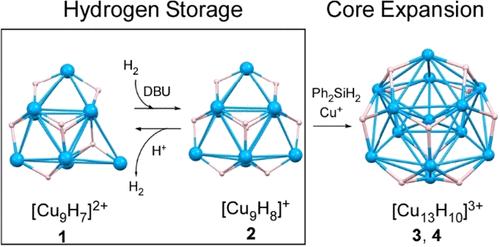具有Cu9和Cu13框架的铜氢化物簇,通过表面盖层和间隙氢化物之间的交换显示出储氢的潜力
IF 4.7
2区 化学
Q1 CHEMISTRY, INORGANIC & NUCLEAR
引用次数: 0
摘要
利用meso-Ph2PCH2P(Ph)(CH2)3P(Ph)CH2PPh2 (meso-dpmppp)合成了新的氢化铜簇[Cu9H7(meso-dpmppp)3]X2 (X = PF6 (1a), BF4 (1b), BPh4 (1c)),并对其具有4,4,4三向三角棱镜(TTP) Cu9核进行了表征。1a,b经LiBH4处理转化为[Cu9H8(meso-dpmppp)3]X (X = PF6 (2a), BF4 (2b)),在保留TTP Cu9核心的同时容纳了一个额外的氢化物。与2中的8个面盖氢化物的静态特性相反,1中的7个氢化物中有5个表现出流动行为,可以在- 80℃下冷冻成4个面盖氢化物和1个间隙氢化物。在Ph2SiH2和[Cu(MeCN)4]BF4的作用下,1b的Cu9核可以扩展,得到[Cu13H10(meso-dpmppp)3(MeCN)3](BF4)3(3)的中心二十面体(CIH) Cu13核。用meso-Ph2PCH2P(Ph)CH2N(CH2C6H5)CH2P(Ph)CH2PPh2 (meso-dpmppmNBn)合成了类似的CIH簇[Cu13H10(meso-dpmppmNBn)3(MeCN)3](BF4)3(4)。在DBU(1,8-重氮双环[5.4.0]-7-十一烯)存在的情况下,用H2 (1atm)处理1a,可以定量地得到2a, 2a很容易与1等量的TfOH或phh反应,转化回1a,同时形成H2,这表明通过TTP支架周围的面盖和间隙氢化物之间的通量交换,可能存在储氢的潜力。本文章由计算机程序翻译,如有差异,请以英文原文为准。

Copper Hydride Clusters with Cu9 and Cu13 Frameworks, Showing a Potential for Hydrogen Storage via Fluxional Exchange between Face-Capping and Interstitial Hydrides
Using meso-Ph2PCH2P(Ph)(CH2)3P(Ph)CH2PPh2 (meso-dpmppp), new copper hydride clusters, [Cu9H7(meso-dpmppp)3]X2 (X = PF6 (1a), BF4 (1b), and BPh4 (1c)), were synthesized and characterized to have a 4,4,4-tricapped trigonal prism (TTP) Cu9 core. 1a,b was converted by treatment with LiBH4 to [Cu9H8(meso-dpmppp)3]X (X = PF6 (2a), BF4 (2b)), which accommodates an additional hydride while retaining the TTP Cu9 core. In contrast to the static property of the eight face-capping hydrides of 2, five of the seven hydrides in 1 exhibited the fluxional behavior, which could be frozen at −80 °C into four face-capping and one interstitial hydrides. The Cu9 core of 1b could be expanded by treating with Ph2SiH2 and [Cu(MeCN)4]BF4 to give the centered icosahedral (CIH) Cu13 core of [Cu13H10(meso-dpmppp)3(MeCN)3](BF4)3 (3). The similar CIH cluster of [Cu13H10(meso-dpmppmNBn)3(MeCN)3](BF4)3 (4) was also synthesized using meso-Ph2PCH2P(Ph)CH2N(CH2C6H5)CH2P(Ph)CH2PPh2 (meso-dpmppmNBn). Treatment of 1a with H2 (1 atm) in the presence of DBU (1,8-diazabicyclo[5.4.0]-7-undecene) gave 2a quantitatively, and 2a reacted easily with 1 equiv of TfOH or PhOH to be converted back to 1a with concomitant H2 formation, suggesting a potential for hydrogen storage through the fluxional exchange between face-capping and interstitial hydrides around the TTP scaffold.
求助全文
通过发布文献求助,成功后即可免费获取论文全文。
去求助
来源期刊

Inorganic Chemistry
化学-无机化学与核化学
CiteScore
7.60
自引率
13.00%
发文量
1960
审稿时长
1.9 months
期刊介绍:
Inorganic Chemistry publishes fundamental studies in all phases of inorganic chemistry. Coverage includes experimental and theoretical reports on quantitative studies of structure and thermodynamics, kinetics, mechanisms of inorganic reactions, bioinorganic chemistry, and relevant aspects of organometallic chemistry, solid-state phenomena, and chemical bonding theory. Emphasis is placed on the synthesis, structure, thermodynamics, reactivity, spectroscopy, and bonding properties of significant new and known compounds.
 求助内容:
求助内容: 应助结果提醒方式:
应助结果提醒方式:


